Business Environment of Tesco PLC: A Comprehensive PESTEL Analysis
VerifiedAdded on 2023/01/10
|13
|3575
|53
Report
AI Summary
This report provides a comprehensive analysis of Tesco PLC's business environment, focusing on its governance and organizational structure, and the application of the PESTEL framework. It begins with an overview of Tesco, including its history and organizational structure, detailing how the company is managed both nationally and internationally. The report then examines Tesco PLC's governance, highlighting the role of the Board of Directors, the number of executive and non-executive directors, and the roles of the Chairperson and CEO. Furthermore, it emphasizes the importance of conducting a PESTEL analysis for organizations, explaining how it aids in identifying macro-environmental factors, dynamic changes, and assessing strengths and weaknesses. Finally, the report applies the PESTEL framework to Tesco PLC, listing and analyzing the political, economic, social-cultural, technological, environmental, and legal factors that influence its business environment, providing practical examples to illustrate each point. This analysis helps to understand the external constraints and opportunities impacting Tesco's strategic decisions and overall performance.
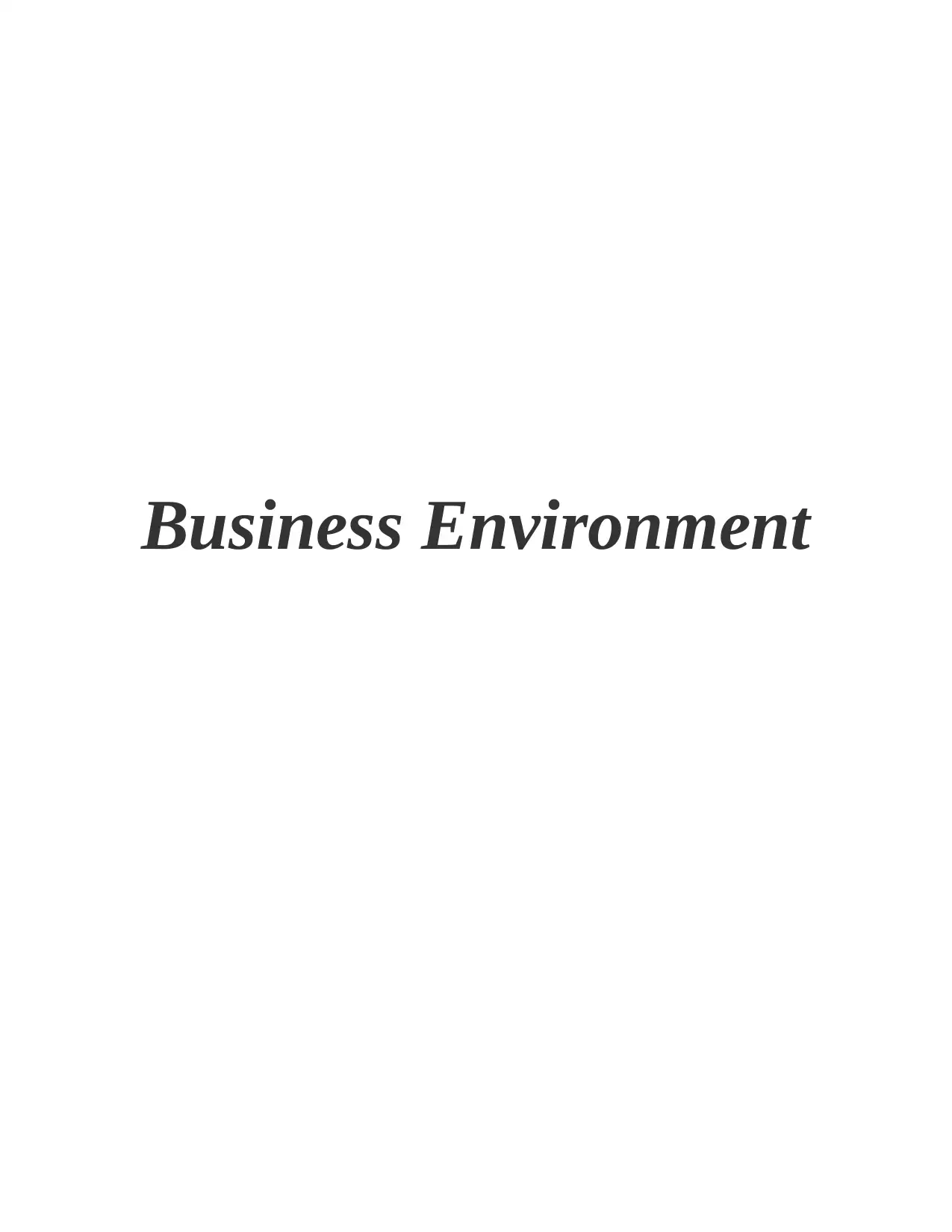
Business Environment
Paraphrase This Document
Need a fresh take? Get an instant paraphrase of this document with our AI Paraphraser
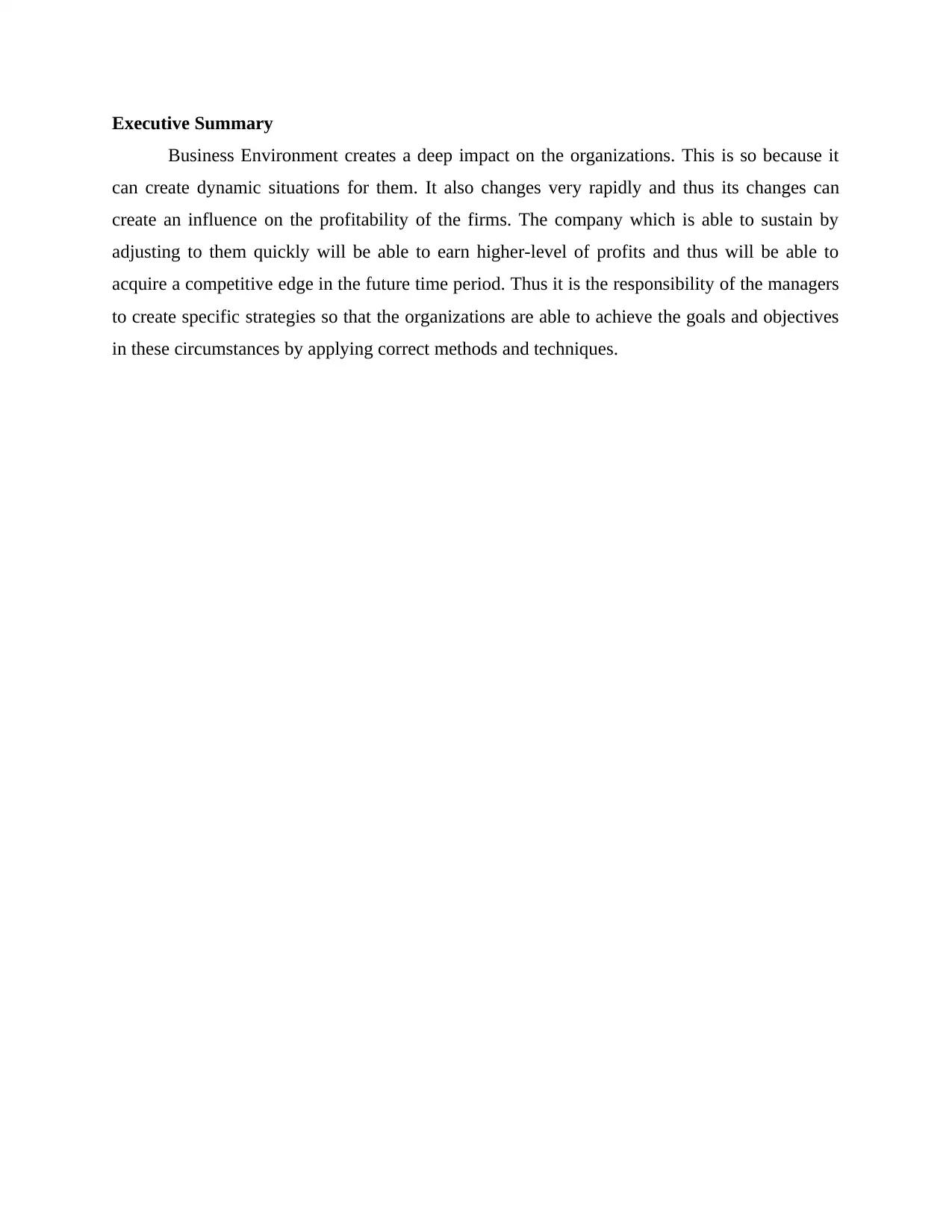
Executive Summary
Business Environment creates a deep impact on the organizations. This is so because it
can create dynamic situations for them. It also changes very rapidly and thus its changes can
create an influence on the profitability of the firms. The company which is able to sustain by
adjusting to them quickly will be able to earn higher-level of profits and thus will be able to
acquire a competitive edge in the future time period. Thus it is the responsibility of the managers
to create specific strategies so that the organizations are able to achieve the goals and objectives
in these circumstances by applying correct methods and techniques.
Business Environment creates a deep impact on the organizations. This is so because it
can create dynamic situations for them. It also changes very rapidly and thus its changes can
create an influence on the profitability of the firms. The company which is able to sustain by
adjusting to them quickly will be able to earn higher-level of profits and thus will be able to
acquire a competitive edge in the future time period. Thus it is the responsibility of the managers
to create specific strategies so that the organizations are able to achieve the goals and objectives
in these circumstances by applying correct methods and techniques.
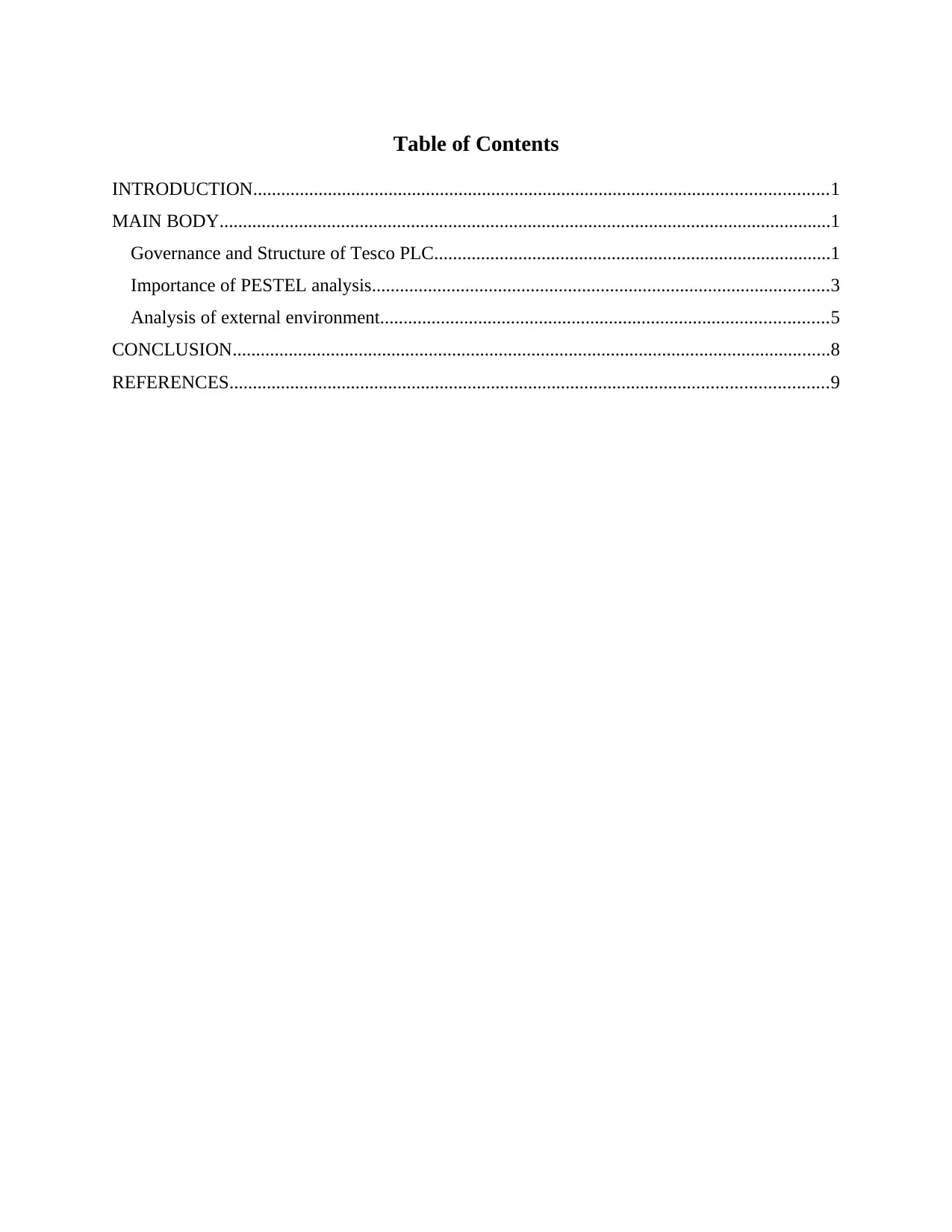
Table of Contents
INTRODUCTION...........................................................................................................................1
MAIN BODY...................................................................................................................................1
Governance and Structure of Tesco PLC.....................................................................................1
Importance of PESTEL analysis..................................................................................................3
Analysis of external environment................................................................................................5
CONCLUSION................................................................................................................................8
REFERENCES................................................................................................................................9
INTRODUCTION...........................................................................................................................1
MAIN BODY...................................................................................................................................1
Governance and Structure of Tesco PLC.....................................................................................1
Importance of PESTEL analysis..................................................................................................3
Analysis of external environment................................................................................................5
CONCLUSION................................................................................................................................8
REFERENCES................................................................................................................................9
⊘ This is a preview!⊘
Do you want full access?
Subscribe today to unlock all pages.

Trusted by 1+ million students worldwide
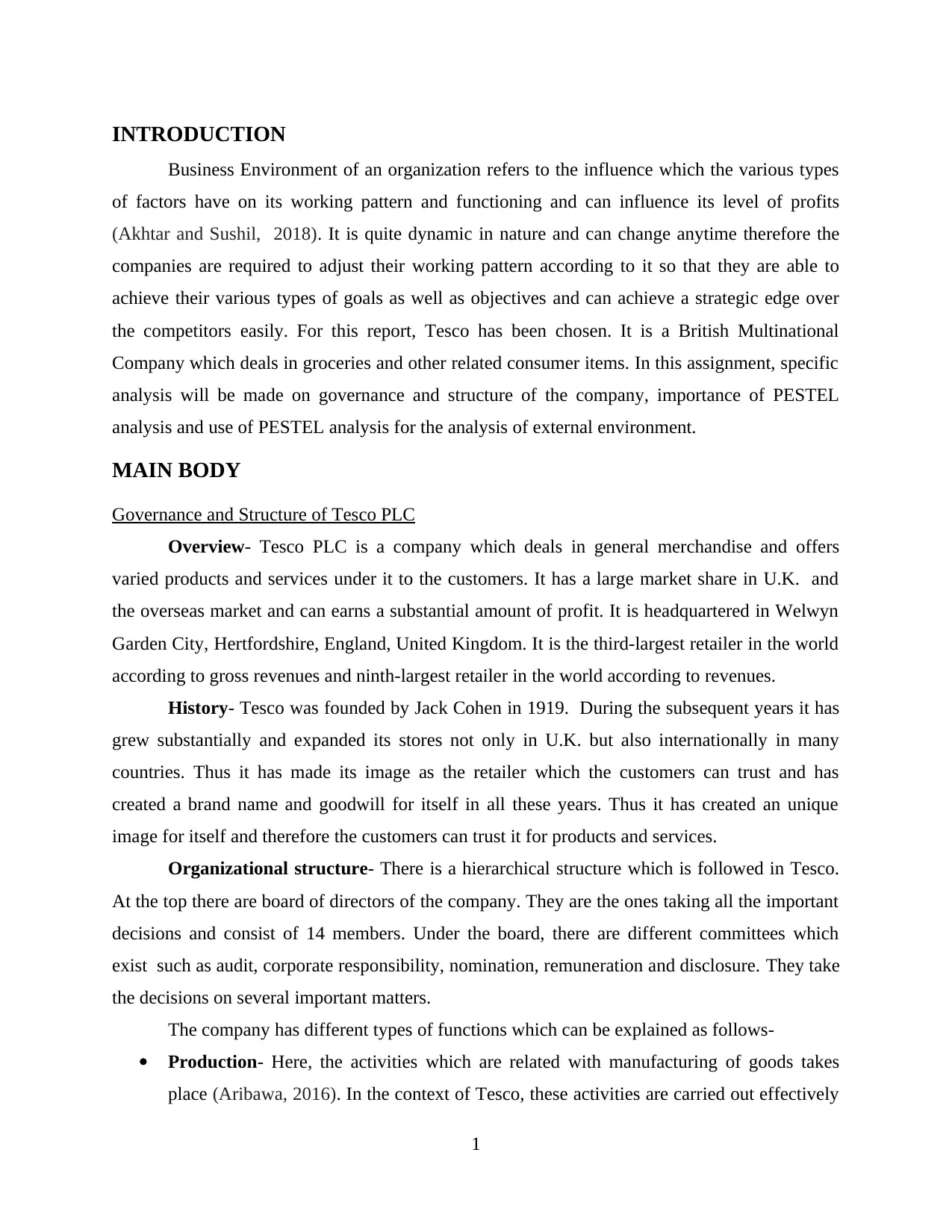
INTRODUCTION
Business Environment of an organization refers to the influence which the various types
of factors have on its working pattern and functioning and can influence its level of profits
(Akhtar and Sushil, 2018). It is quite dynamic in nature and can change anytime therefore the
companies are required to adjust their working pattern according to it so that they are able to
achieve their various types of goals as well as objectives and can achieve a strategic edge over
the competitors easily. For this report, Tesco has been chosen. It is a British Multinational
Company which deals in groceries and other related consumer items. In this assignment, specific
analysis will be made on governance and structure of the company, importance of PESTEL
analysis and use of PESTEL analysis for the analysis of external environment.
MAIN BODY
Governance and Structure of Tesco PLC
Overview- Tesco PLC is a company which deals in general merchandise and offers
varied products and services under it to the customers. It has a large market share in U.K. and
the overseas market and can earns a substantial amount of profit. It is headquartered in Welwyn
Garden City, Hertfordshire, England, United Kingdom. It is the third-largest retailer in the world
according to gross revenues and ninth-largest retailer in the world according to revenues.
History- Tesco was founded by Jack Cohen in 1919. During the subsequent years it has
grew substantially and expanded its stores not only in U.K. but also internationally in many
countries. Thus it has made its image as the retailer which the customers can trust and has
created a brand name and goodwill for itself in all these years. Thus it has created an unique
image for itself and therefore the customers can trust it for products and services.
Organizational structure- There is a hierarchical structure which is followed in Tesco.
At the top there are board of directors of the company. They are the ones taking all the important
decisions and consist of 14 members. Under the board, there are different committees which
exist such as audit, corporate responsibility, nomination, remuneration and disclosure. They take
the decisions on several important matters.
The company has different types of functions which can be explained as follows-
Production- Here, the activities which are related with manufacturing of goods takes
place (Aribawa, 2016). In the context of Tesco, these activities are carried out effectively
1
Business Environment of an organization refers to the influence which the various types
of factors have on its working pattern and functioning and can influence its level of profits
(Akhtar and Sushil, 2018). It is quite dynamic in nature and can change anytime therefore the
companies are required to adjust their working pattern according to it so that they are able to
achieve their various types of goals as well as objectives and can achieve a strategic edge over
the competitors easily. For this report, Tesco has been chosen. It is a British Multinational
Company which deals in groceries and other related consumer items. In this assignment, specific
analysis will be made on governance and structure of the company, importance of PESTEL
analysis and use of PESTEL analysis for the analysis of external environment.
MAIN BODY
Governance and Structure of Tesco PLC
Overview- Tesco PLC is a company which deals in general merchandise and offers
varied products and services under it to the customers. It has a large market share in U.K. and
the overseas market and can earns a substantial amount of profit. It is headquartered in Welwyn
Garden City, Hertfordshire, England, United Kingdom. It is the third-largest retailer in the world
according to gross revenues and ninth-largest retailer in the world according to revenues.
History- Tesco was founded by Jack Cohen in 1919. During the subsequent years it has
grew substantially and expanded its stores not only in U.K. but also internationally in many
countries. Thus it has made its image as the retailer which the customers can trust and has
created a brand name and goodwill for itself in all these years. Thus it has created an unique
image for itself and therefore the customers can trust it for products and services.
Organizational structure- There is a hierarchical structure which is followed in Tesco.
At the top there are board of directors of the company. They are the ones taking all the important
decisions and consist of 14 members. Under the board, there are different committees which
exist such as audit, corporate responsibility, nomination, remuneration and disclosure. They take
the decisions on several important matters.
The company has different types of functions which can be explained as follows-
Production- Here, the activities which are related with manufacturing of goods takes
place (Aribawa, 2016). In the context of Tesco, these activities are carried out effectively
1
Paraphrase This Document
Need a fresh take? Get an instant paraphrase of this document with our AI Paraphraser
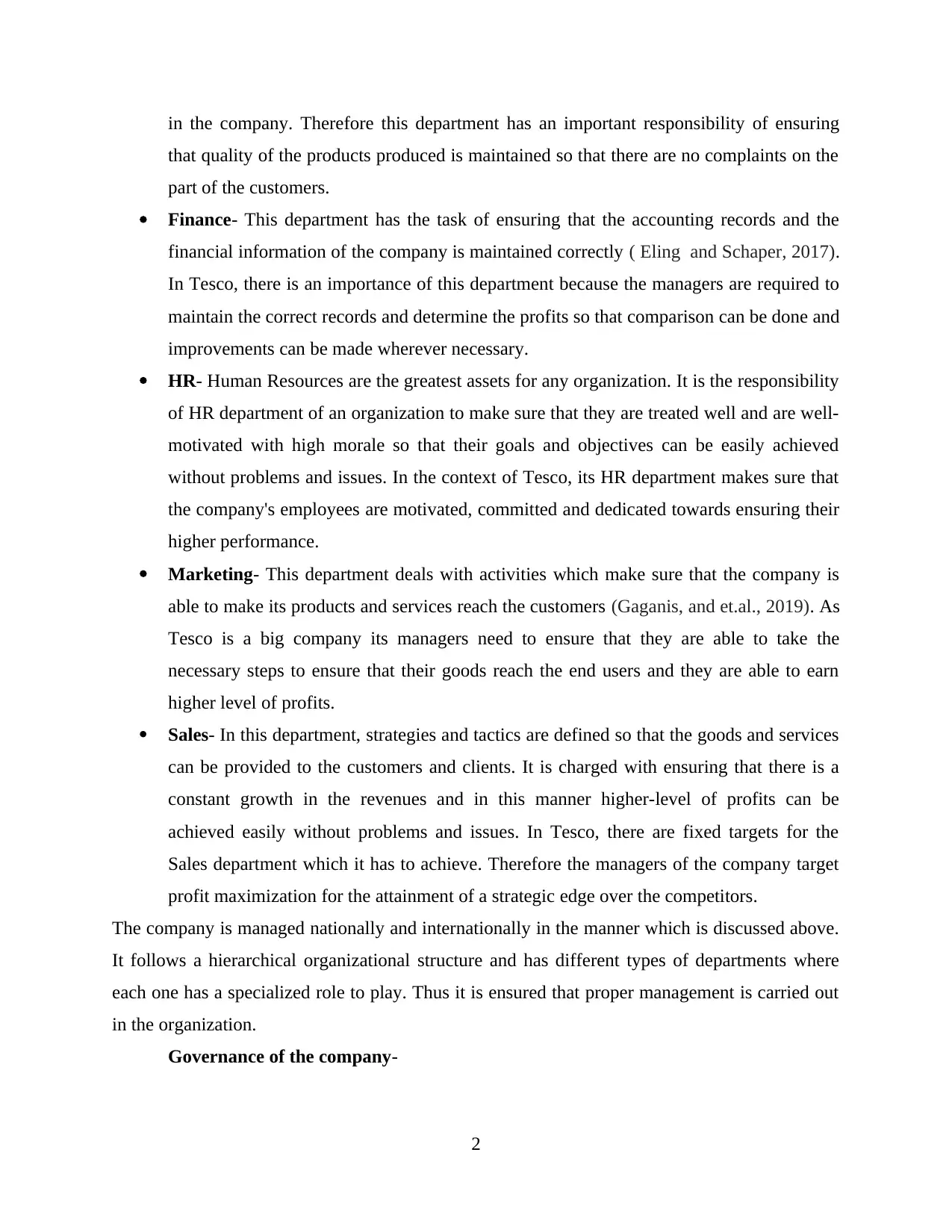
in the company. Therefore this department has an important responsibility of ensuring
that quality of the products produced is maintained so that there are no complaints on the
part of the customers.
Finance- This department has the task of ensuring that the accounting records and the
financial information of the company is maintained correctly ( Eling and Schaper, 2017).
In Tesco, there is an importance of this department because the managers are required to
maintain the correct records and determine the profits so that comparison can be done and
improvements can be made wherever necessary.
HR- Human Resources are the greatest assets for any organization. It is the responsibility
of HR department of an organization to make sure that they are treated well and are well-
motivated with high morale so that their goals and objectives can be easily achieved
without problems and issues. In the context of Tesco, its HR department makes sure that
the company's employees are motivated, committed and dedicated towards ensuring their
higher performance.
Marketing- This department deals with activities which make sure that the company is
able to make its products and services reach the customers (Gaganis, and et.al., 2019). As
Tesco is a big company its managers need to ensure that they are able to take the
necessary steps to ensure that their goods reach the end users and they are able to earn
higher level of profits.
Sales- In this department, strategies and tactics are defined so that the goods and services
can be provided to the customers and clients. It is charged with ensuring that there is a
constant growth in the revenues and in this manner higher-level of profits can be
achieved easily without problems and issues. In Tesco, there are fixed targets for the
Sales department which it has to achieve. Therefore the managers of the company target
profit maximization for the attainment of a strategic edge over the competitors.
The company is managed nationally and internationally in the manner which is discussed above.
It follows a hierarchical organizational structure and has different types of departments where
each one has a specialized role to play. Thus it is ensured that proper management is carried out
in the organization.
Governance of the company-
2
that quality of the products produced is maintained so that there are no complaints on the
part of the customers.
Finance- This department has the task of ensuring that the accounting records and the
financial information of the company is maintained correctly ( Eling and Schaper, 2017).
In Tesco, there is an importance of this department because the managers are required to
maintain the correct records and determine the profits so that comparison can be done and
improvements can be made wherever necessary.
HR- Human Resources are the greatest assets for any organization. It is the responsibility
of HR department of an organization to make sure that they are treated well and are well-
motivated with high morale so that their goals and objectives can be easily achieved
without problems and issues. In the context of Tesco, its HR department makes sure that
the company's employees are motivated, committed and dedicated towards ensuring their
higher performance.
Marketing- This department deals with activities which make sure that the company is
able to make its products and services reach the customers (Gaganis, and et.al., 2019). As
Tesco is a big company its managers need to ensure that they are able to take the
necessary steps to ensure that their goods reach the end users and they are able to earn
higher level of profits.
Sales- In this department, strategies and tactics are defined so that the goods and services
can be provided to the customers and clients. It is charged with ensuring that there is a
constant growth in the revenues and in this manner higher-level of profits can be
achieved easily without problems and issues. In Tesco, there are fixed targets for the
Sales department which it has to achieve. Therefore the managers of the company target
profit maximization for the attainment of a strategic edge over the competitors.
The company is managed nationally and internationally in the manner which is discussed above.
It follows a hierarchical organizational structure and has different types of departments where
each one has a specialized role to play. Thus it is ensured that proper management is carried out
in the organization.
Governance of the company-
2
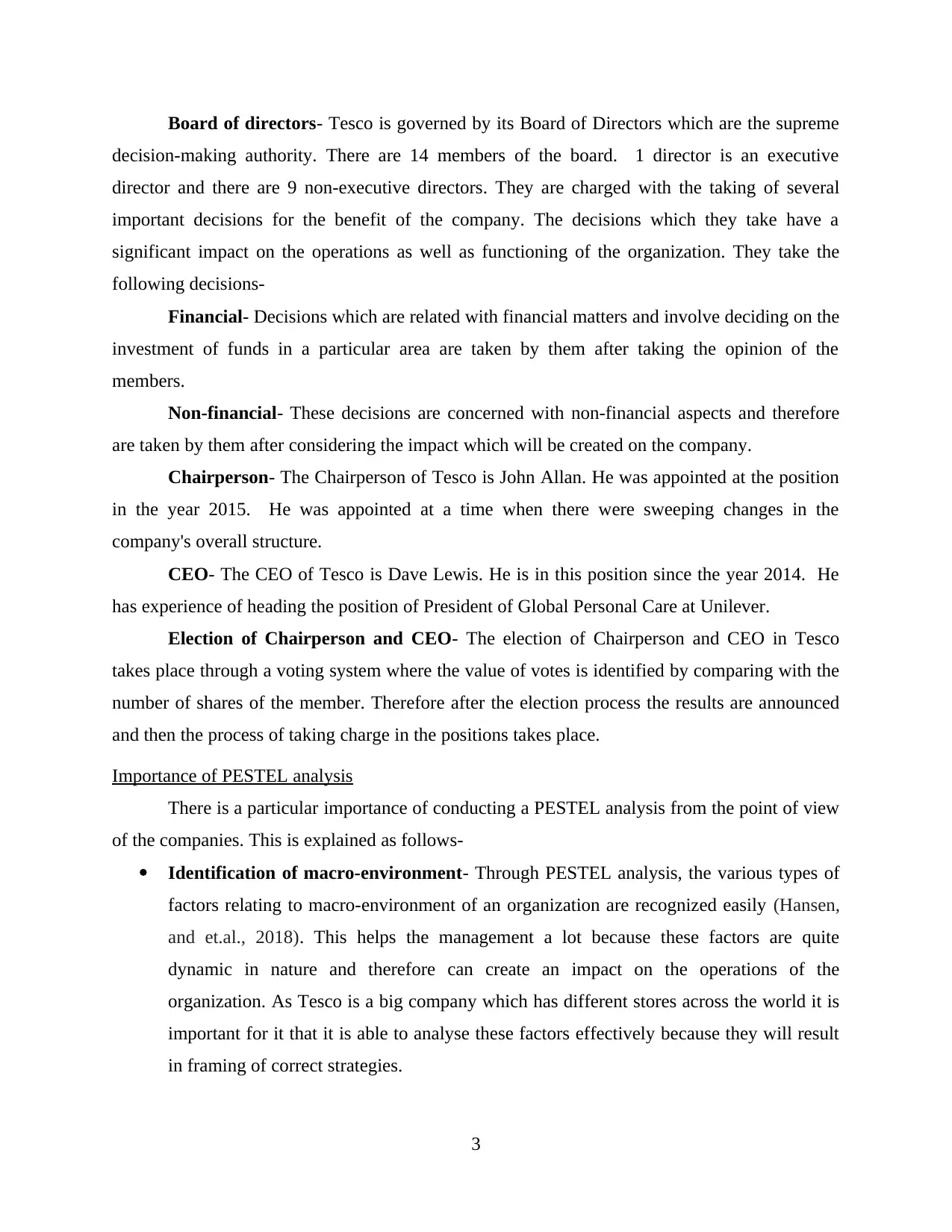
Board of directors- Tesco is governed by its Board of Directors which are the supreme
decision-making authority. There are 14 members of the board. 1 director is an executive
director and there are 9 non-executive directors. They are charged with the taking of several
important decisions for the benefit of the company. The decisions which they take have a
significant impact on the operations as well as functioning of the organization. They take the
following decisions-
Financial- Decisions which are related with financial matters and involve deciding on the
investment of funds in a particular area are taken by them after taking the opinion of the
members.
Non-financial- These decisions are concerned with non-financial aspects and therefore
are taken by them after considering the impact which will be created on the company.
Chairperson- The Chairperson of Tesco is John Allan. He was appointed at the position
in the year 2015. He was appointed at a time when there were sweeping changes in the
company's overall structure.
CEO- The CEO of Tesco is Dave Lewis. He is in this position since the year 2014. He
has experience of heading the position of President of Global Personal Care at Unilever.
Election of Chairperson and CEO- The election of Chairperson and CEO in Tesco
takes place through a voting system where the value of votes is identified by comparing with the
number of shares of the member. Therefore after the election process the results are announced
and then the process of taking charge in the positions takes place.
Importance of PESTEL analysis
There is a particular importance of conducting a PESTEL analysis from the point of view
of the companies. This is explained as follows-
Identification of macro-environment- Through PESTEL analysis, the various types of
factors relating to macro-environment of an organization are recognized easily (Hansen,
and et.al., 2018). This helps the management a lot because these factors are quite
dynamic in nature and therefore can create an impact on the operations of the
organization. As Tesco is a big company which has different stores across the world it is
important for it that it is able to analyse these factors effectively because they will result
in framing of correct strategies.
3
decision-making authority. There are 14 members of the board. 1 director is an executive
director and there are 9 non-executive directors. They are charged with the taking of several
important decisions for the benefit of the company. The decisions which they take have a
significant impact on the operations as well as functioning of the organization. They take the
following decisions-
Financial- Decisions which are related with financial matters and involve deciding on the
investment of funds in a particular area are taken by them after taking the opinion of the
members.
Non-financial- These decisions are concerned with non-financial aspects and therefore
are taken by them after considering the impact which will be created on the company.
Chairperson- The Chairperson of Tesco is John Allan. He was appointed at the position
in the year 2015. He was appointed at a time when there were sweeping changes in the
company's overall structure.
CEO- The CEO of Tesco is Dave Lewis. He is in this position since the year 2014. He
has experience of heading the position of President of Global Personal Care at Unilever.
Election of Chairperson and CEO- The election of Chairperson and CEO in Tesco
takes place through a voting system where the value of votes is identified by comparing with the
number of shares of the member. Therefore after the election process the results are announced
and then the process of taking charge in the positions takes place.
Importance of PESTEL analysis
There is a particular importance of conducting a PESTEL analysis from the point of view
of the companies. This is explained as follows-
Identification of macro-environment- Through PESTEL analysis, the various types of
factors relating to macro-environment of an organization are recognized easily (Hansen,
and et.al., 2018). This helps the management a lot because these factors are quite
dynamic in nature and therefore can create an impact on the operations of the
organization. As Tesco is a big company which has different stores across the world it is
important for it that it is able to analyse these factors effectively because they will result
in framing of correct strategies.
3
⊘ This is a preview!⊘
Do you want full access?
Subscribe today to unlock all pages.

Trusted by 1+ million students worldwide
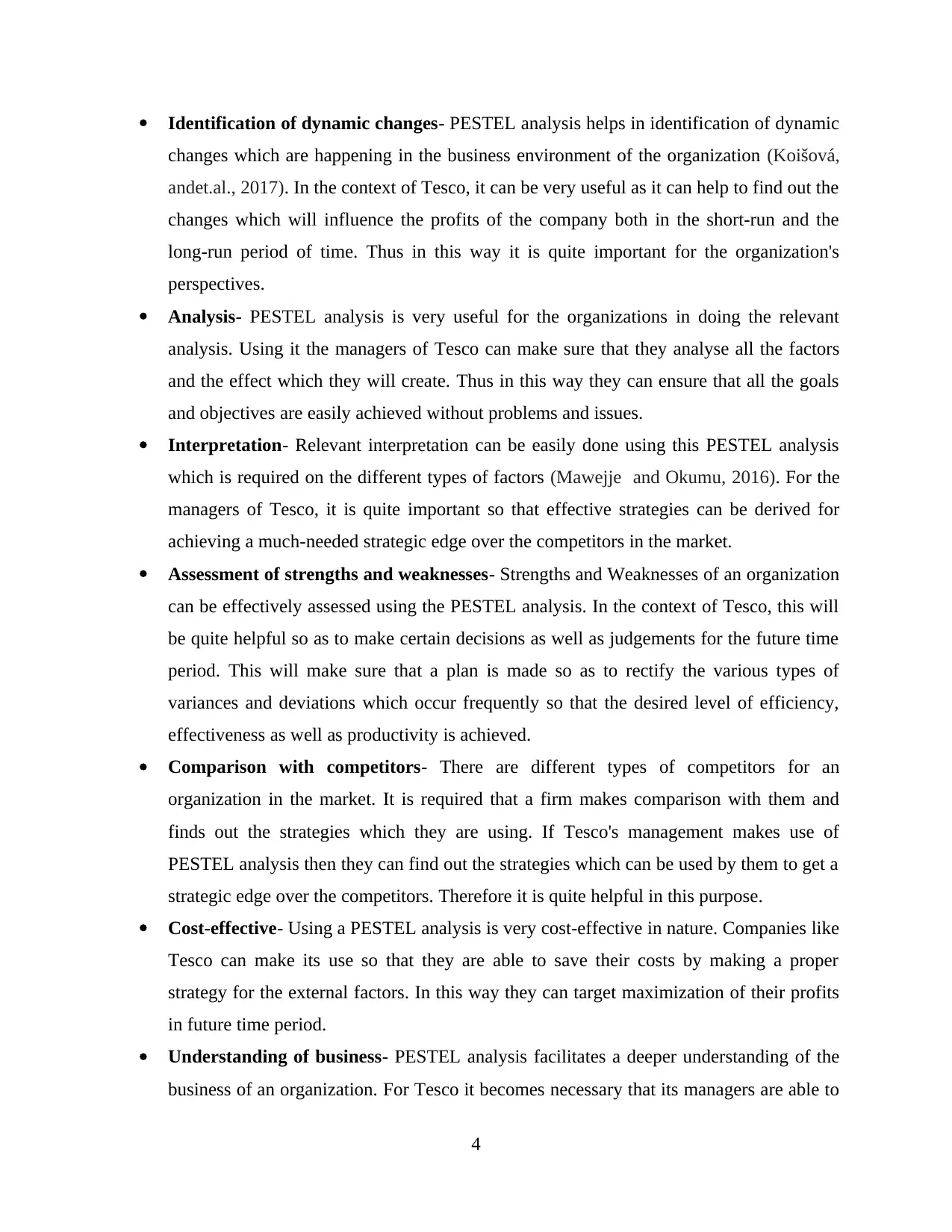
Identification of dynamic changes- PESTEL analysis helps in identification of dynamic
changes which are happening in the business environment of the organization (Koišová,
andet.al., 2017). In the context of Tesco, it can be very useful as it can help to find out the
changes which will influence the profits of the company both in the short-run and the
long-run period of time. Thus in this way it is quite important for the organization's
perspectives.
Analysis- PESTEL analysis is very useful for the organizations in doing the relevant
analysis. Using it the managers of Tesco can make sure that they analyse all the factors
and the effect which they will create. Thus in this way they can ensure that all the goals
and objectives are easily achieved without problems and issues.
Interpretation- Relevant interpretation can be easily done using this PESTEL analysis
which is required on the different types of factors (Mawejje and Okumu, 2016). For the
managers of Tesco, it is quite important so that effective strategies can be derived for
achieving a much-needed strategic edge over the competitors in the market.
Assessment of strengths and weaknesses- Strengths and Weaknesses of an organization
can be effectively assessed using the PESTEL analysis. In the context of Tesco, this will
be quite helpful so as to make certain decisions as well as judgements for the future time
period. This will make sure that a plan is made so as to rectify the various types of
variances and deviations which occur frequently so that the desired level of efficiency,
effectiveness as well as productivity is achieved.
Comparison with competitors- There are different types of competitors for an
organization in the market. It is required that a firm makes comparison with them and
finds out the strategies which they are using. If Tesco's management makes use of
PESTEL analysis then they can find out the strategies which can be used by them to get a
strategic edge over the competitors. Therefore it is quite helpful in this purpose.
Cost-effective- Using a PESTEL analysis is very cost-effective in nature. Companies like
Tesco can make its use so that they are able to save their costs by making a proper
strategy for the external factors. In this way they can target maximization of their profits
in future time period.
Understanding of business- PESTEL analysis facilitates a deeper understanding of the
business of an organization. For Tesco it becomes necessary that its managers are able to
4
changes which are happening in the business environment of the organization (Koišová,
andet.al., 2017). In the context of Tesco, it can be very useful as it can help to find out the
changes which will influence the profits of the company both in the short-run and the
long-run period of time. Thus in this way it is quite important for the organization's
perspectives.
Analysis- PESTEL analysis is very useful for the organizations in doing the relevant
analysis. Using it the managers of Tesco can make sure that they analyse all the factors
and the effect which they will create. Thus in this way they can ensure that all the goals
and objectives are easily achieved without problems and issues.
Interpretation- Relevant interpretation can be easily done using this PESTEL analysis
which is required on the different types of factors (Mawejje and Okumu, 2016). For the
managers of Tesco, it is quite important so that effective strategies can be derived for
achieving a much-needed strategic edge over the competitors in the market.
Assessment of strengths and weaknesses- Strengths and Weaknesses of an organization
can be effectively assessed using the PESTEL analysis. In the context of Tesco, this will
be quite helpful so as to make certain decisions as well as judgements for the future time
period. This will make sure that a plan is made so as to rectify the various types of
variances and deviations which occur frequently so that the desired level of efficiency,
effectiveness as well as productivity is achieved.
Comparison with competitors- There are different types of competitors for an
organization in the market. It is required that a firm makes comparison with them and
finds out the strategies which they are using. If Tesco's management makes use of
PESTEL analysis then they can find out the strategies which can be used by them to get a
strategic edge over the competitors. Therefore it is quite helpful in this purpose.
Cost-effective- Using a PESTEL analysis is very cost-effective in nature. Companies like
Tesco can make its use so that they are able to save their costs by making a proper
strategy for the external factors. In this way they can target maximization of their profits
in future time period.
Understanding of business- PESTEL analysis facilitates a deeper understanding of the
business of an organization. For Tesco it becomes necessary that its managers are able to
4
Paraphrase This Document
Need a fresh take? Get an instant paraphrase of this document with our AI Paraphraser
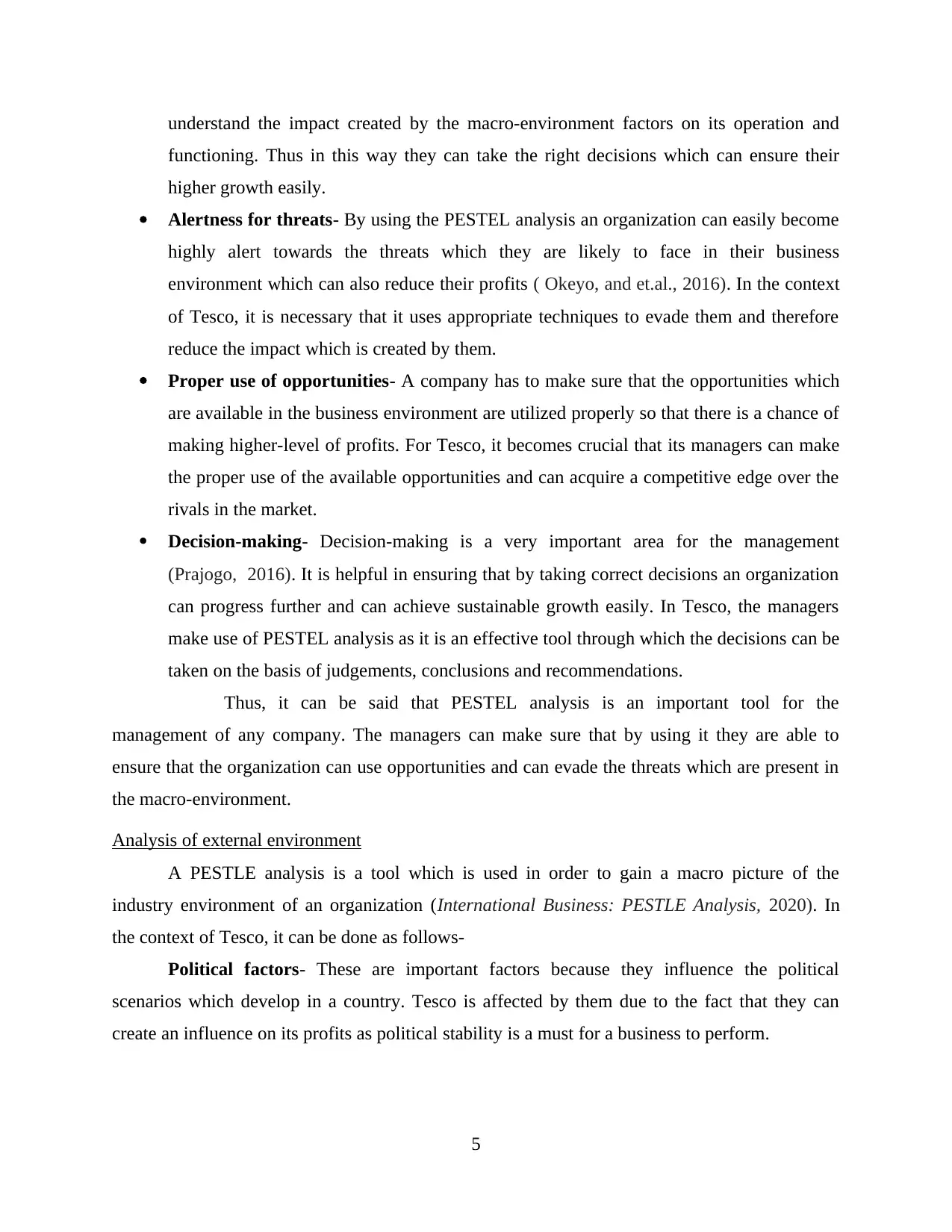
understand the impact created by the macro-environment factors on its operation and
functioning. Thus in this way they can take the right decisions which can ensure their
higher growth easily.
Alertness for threats- By using the PESTEL analysis an organization can easily become
highly alert towards the threats which they are likely to face in their business
environment which can also reduce their profits ( Okeyo, and et.al., 2016). In the context
of Tesco, it is necessary that it uses appropriate techniques to evade them and therefore
reduce the impact which is created by them.
Proper use of opportunities- A company has to make sure that the opportunities which
are available in the business environment are utilized properly so that there is a chance of
making higher-level of profits. For Tesco, it becomes crucial that its managers can make
the proper use of the available opportunities and can acquire a competitive edge over the
rivals in the market.
Decision-making- Decision-making is a very important area for the management
(Prajogo, 2016). It is helpful in ensuring that by taking correct decisions an organization
can progress further and can achieve sustainable growth easily. In Tesco, the managers
make use of PESTEL analysis as it is an effective tool through which the decisions can be
taken on the basis of judgements, conclusions and recommendations.
Thus, it can be said that PESTEL analysis is an important tool for the
management of any company. The managers can make sure that by using it they are able to
ensure that the organization can use opportunities and can evade the threats which are present in
the macro-environment.
Analysis of external environment
A PESTLE analysis is a tool which is used in order to gain a macro picture of the
industry environment of an organization (International Business: PESTLE Analysis, 2020). In
the context of Tesco, it can be done as follows-
Political factors- These are important factors because they influence the political
scenarios which develop in a country. Tesco is affected by them due to the fact that they can
create an influence on its profits as political stability is a must for a business to perform.
5
functioning. Thus in this way they can take the right decisions which can ensure their
higher growth easily.
Alertness for threats- By using the PESTEL analysis an organization can easily become
highly alert towards the threats which they are likely to face in their business
environment which can also reduce their profits ( Okeyo, and et.al., 2016). In the context
of Tesco, it is necessary that it uses appropriate techniques to evade them and therefore
reduce the impact which is created by them.
Proper use of opportunities- A company has to make sure that the opportunities which
are available in the business environment are utilized properly so that there is a chance of
making higher-level of profits. For Tesco, it becomes crucial that its managers can make
the proper use of the available opportunities and can acquire a competitive edge over the
rivals in the market.
Decision-making- Decision-making is a very important area for the management
(Prajogo, 2016). It is helpful in ensuring that by taking correct decisions an organization
can progress further and can achieve sustainable growth easily. In Tesco, the managers
make use of PESTEL analysis as it is an effective tool through which the decisions can be
taken on the basis of judgements, conclusions and recommendations.
Thus, it can be said that PESTEL analysis is an important tool for the
management of any company. The managers can make sure that by using it they are able to
ensure that the organization can use opportunities and can evade the threats which are present in
the macro-environment.
Analysis of external environment
A PESTLE analysis is a tool which is used in order to gain a macro picture of the
industry environment of an organization (International Business: PESTLE Analysis, 2020). In
the context of Tesco, it can be done as follows-
Political factors- These are important factors because they influence the political
scenarios which develop in a country. Tesco is affected by them due to the fact that they can
create an influence on its profits as political stability is a must for a business to perform.
5
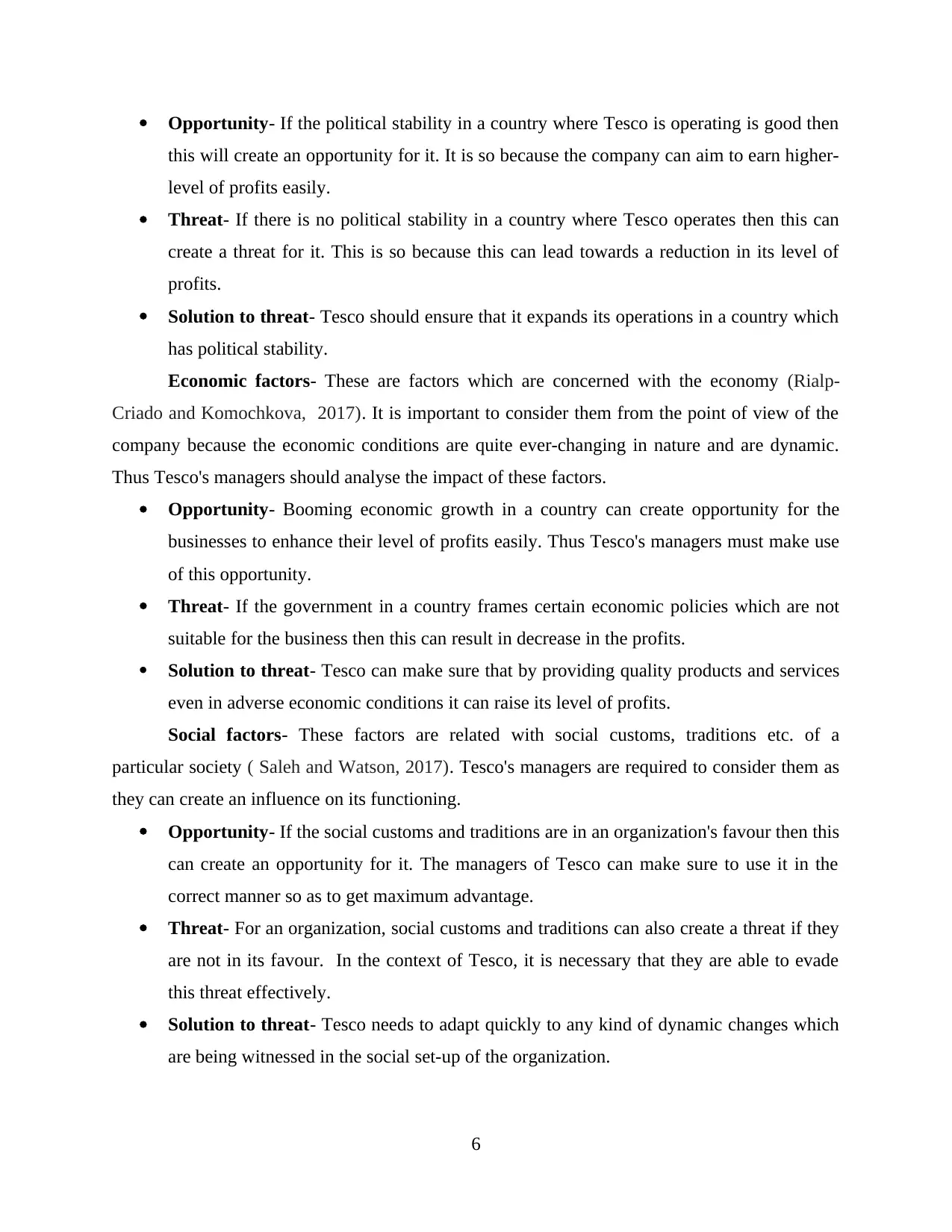
Opportunity- If the political stability in a country where Tesco is operating is good then
this will create an opportunity for it. It is so because the company can aim to earn higher-
level of profits easily.
Threat- If there is no political stability in a country where Tesco operates then this can
create a threat for it. This is so because this can lead towards a reduction in its level of
profits.
Solution to threat- Tesco should ensure that it expands its operations in a country which
has political stability.
Economic factors- These are factors which are concerned with the economy (Rialp-
Criado and Komochkova, 2017). It is important to consider them from the point of view of the
company because the economic conditions are quite ever-changing in nature and are dynamic.
Thus Tesco's managers should analyse the impact of these factors.
Opportunity- Booming economic growth in a country can create opportunity for the
businesses to enhance their level of profits easily. Thus Tesco's managers must make use
of this opportunity.
Threat- If the government in a country frames certain economic policies which are not
suitable for the business then this can result in decrease in the profits.
Solution to threat- Tesco can make sure that by providing quality products and services
even in adverse economic conditions it can raise its level of profits.
Social factors- These factors are related with social customs, traditions etc. of a
particular society ( Saleh and Watson, 2017). Tesco's managers are required to consider them as
they can create an influence on its functioning.
Opportunity- If the social customs and traditions are in an organization's favour then this
can create an opportunity for it. The managers of Tesco can make sure to use it in the
correct manner so as to get maximum advantage.
Threat- For an organization, social customs and traditions can also create a threat if they
are not in its favour. In the context of Tesco, it is necessary that they are able to evade
this threat effectively.
Solution to threat- Tesco needs to adapt quickly to any kind of dynamic changes which
are being witnessed in the social set-up of the organization.
6
this will create an opportunity for it. It is so because the company can aim to earn higher-
level of profits easily.
Threat- If there is no political stability in a country where Tesco operates then this can
create a threat for it. This is so because this can lead towards a reduction in its level of
profits.
Solution to threat- Tesco should ensure that it expands its operations in a country which
has political stability.
Economic factors- These are factors which are concerned with the economy (Rialp-
Criado and Komochkova, 2017). It is important to consider them from the point of view of the
company because the economic conditions are quite ever-changing in nature and are dynamic.
Thus Tesco's managers should analyse the impact of these factors.
Opportunity- Booming economic growth in a country can create opportunity for the
businesses to enhance their level of profits easily. Thus Tesco's managers must make use
of this opportunity.
Threat- If the government in a country frames certain economic policies which are not
suitable for the business then this can result in decrease in the profits.
Solution to threat- Tesco can make sure that by providing quality products and services
even in adverse economic conditions it can raise its level of profits.
Social factors- These factors are related with social customs, traditions etc. of a
particular society ( Saleh and Watson, 2017). Tesco's managers are required to consider them as
they can create an influence on its functioning.
Opportunity- If the social customs and traditions are in an organization's favour then this
can create an opportunity for it. The managers of Tesco can make sure to use it in the
correct manner so as to get maximum advantage.
Threat- For an organization, social customs and traditions can also create a threat if they
are not in its favour. In the context of Tesco, it is necessary that they are able to evade
this threat effectively.
Solution to threat- Tesco needs to adapt quickly to any kind of dynamic changes which
are being witnessed in the social set-up of the organization.
6
⊘ This is a preview!⊘
Do you want full access?
Subscribe today to unlock all pages.

Trusted by 1+ million students worldwide
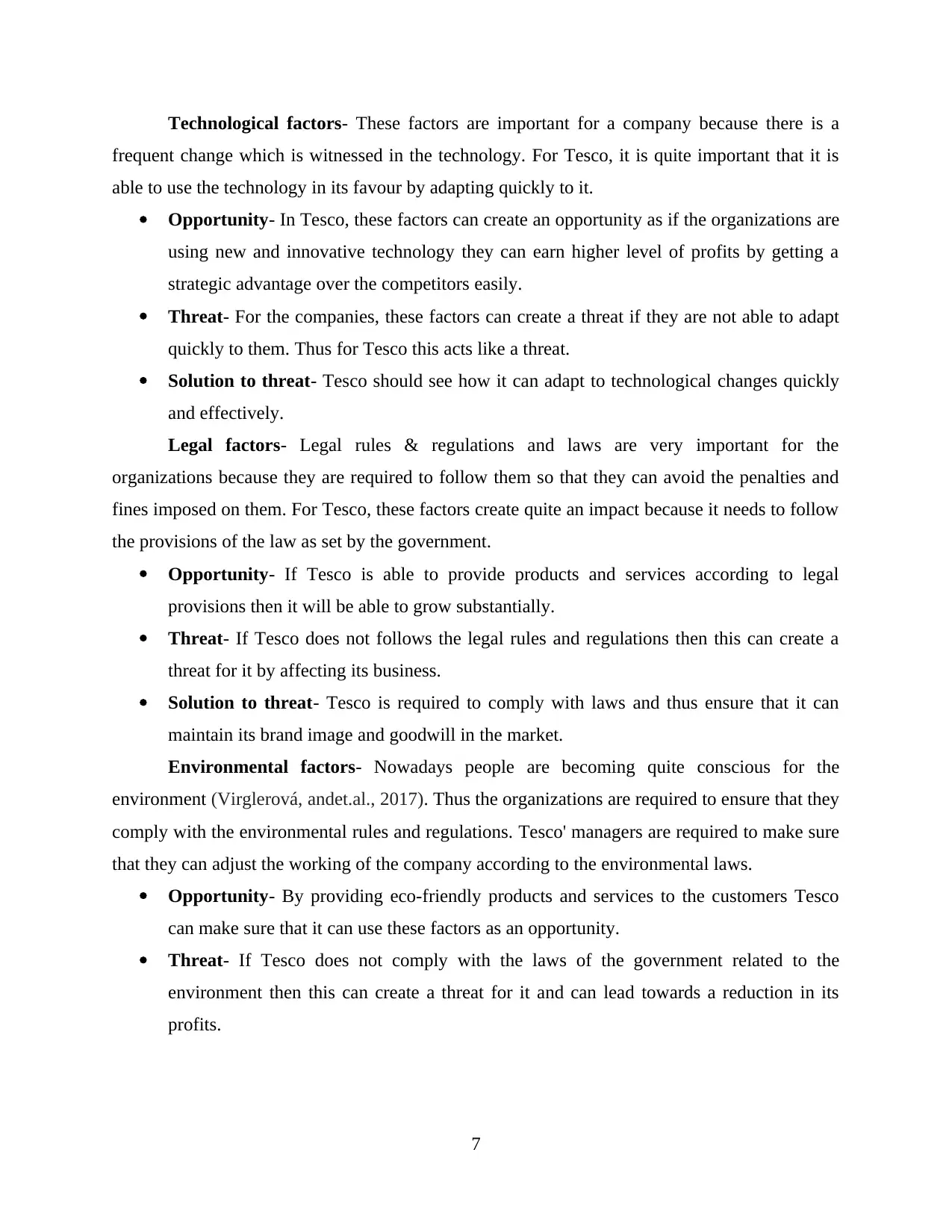
Technological factors- These factors are important for a company because there is a
frequent change which is witnessed in the technology. For Tesco, it is quite important that it is
able to use the technology in its favour by adapting quickly to it.
Opportunity- In Tesco, these factors can create an opportunity as if the organizations are
using new and innovative technology they can earn higher level of profits by getting a
strategic advantage over the competitors easily.
Threat- For the companies, these factors can create a threat if they are not able to adapt
quickly to them. Thus for Tesco this acts like a threat.
Solution to threat- Tesco should see how it can adapt to technological changes quickly
and effectively.
Legal factors- Legal rules & regulations and laws are very important for the
organizations because they are required to follow them so that they can avoid the penalties and
fines imposed on them. For Tesco, these factors create quite an impact because it needs to follow
the provisions of the law as set by the government.
Opportunity- If Tesco is able to provide products and services according to legal
provisions then it will be able to grow substantially.
Threat- If Tesco does not follows the legal rules and regulations then this can create a
threat for it by affecting its business.
Solution to threat- Tesco is required to comply with laws and thus ensure that it can
maintain its brand image and goodwill in the market.
Environmental factors- Nowadays people are becoming quite conscious for the
environment (Virglerová, andet.al., 2017). Thus the organizations are required to ensure that they
comply with the environmental rules and regulations. Tesco' managers are required to make sure
that they can adjust the working of the company according to the environmental laws.
Opportunity- By providing eco-friendly products and services to the customers Tesco
can make sure that it can use these factors as an opportunity.
Threat- If Tesco does not comply with the laws of the government related to the
environment then this can create a threat for it and can lead towards a reduction in its
profits.
7
frequent change which is witnessed in the technology. For Tesco, it is quite important that it is
able to use the technology in its favour by adapting quickly to it.
Opportunity- In Tesco, these factors can create an opportunity as if the organizations are
using new and innovative technology they can earn higher level of profits by getting a
strategic advantage over the competitors easily.
Threat- For the companies, these factors can create a threat if they are not able to adapt
quickly to them. Thus for Tesco this acts like a threat.
Solution to threat- Tesco should see how it can adapt to technological changes quickly
and effectively.
Legal factors- Legal rules & regulations and laws are very important for the
organizations because they are required to follow them so that they can avoid the penalties and
fines imposed on them. For Tesco, these factors create quite an impact because it needs to follow
the provisions of the law as set by the government.
Opportunity- If Tesco is able to provide products and services according to legal
provisions then it will be able to grow substantially.
Threat- If Tesco does not follows the legal rules and regulations then this can create a
threat for it by affecting its business.
Solution to threat- Tesco is required to comply with laws and thus ensure that it can
maintain its brand image and goodwill in the market.
Environmental factors- Nowadays people are becoming quite conscious for the
environment (Virglerová, andet.al., 2017). Thus the organizations are required to ensure that they
comply with the environmental rules and regulations. Tesco' managers are required to make sure
that they can adjust the working of the company according to the environmental laws.
Opportunity- By providing eco-friendly products and services to the customers Tesco
can make sure that it can use these factors as an opportunity.
Threat- If Tesco does not comply with the laws of the government related to the
environment then this can create a threat for it and can lead towards a reduction in its
profits.
7
Paraphrase This Document
Need a fresh take? Get an instant paraphrase of this document with our AI Paraphraser
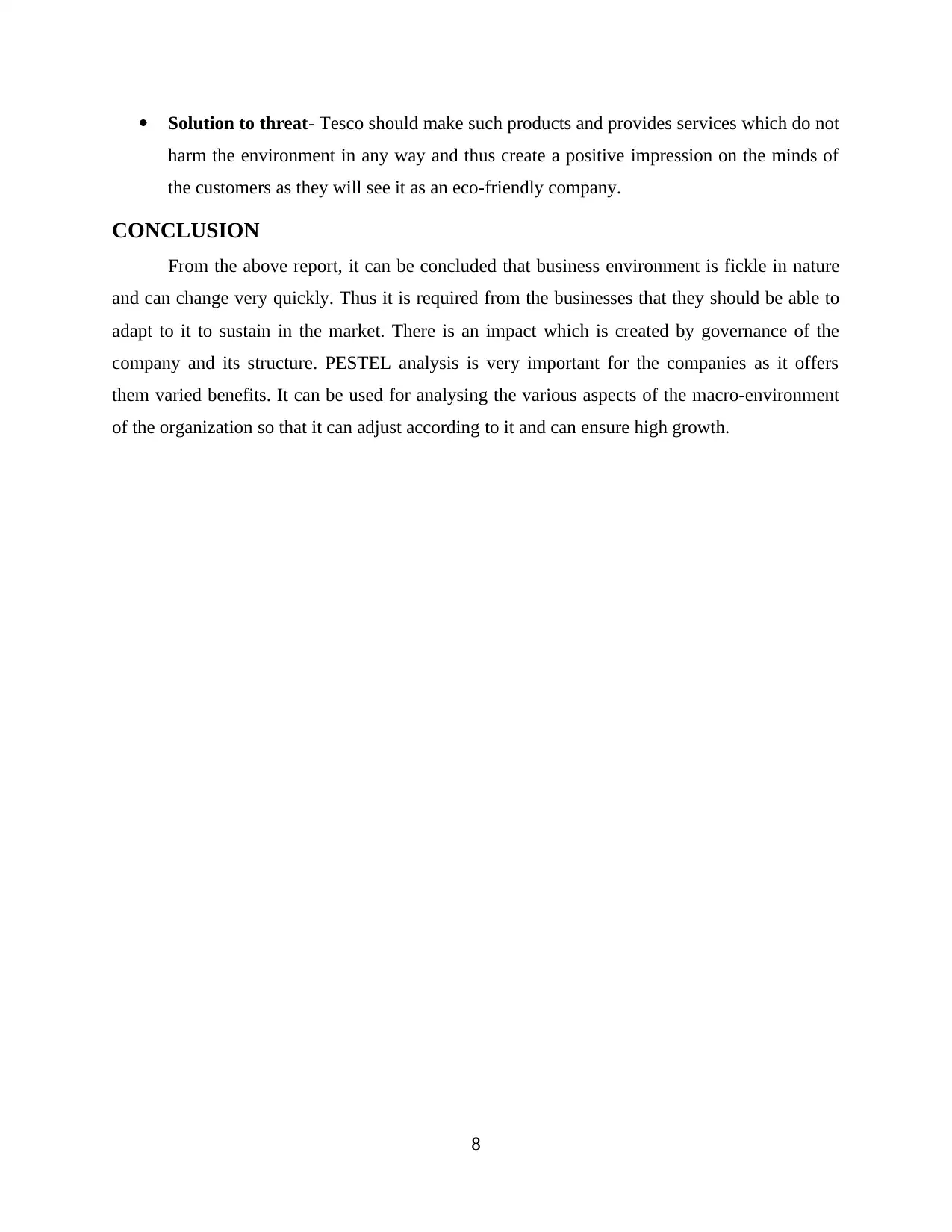
Solution to threat- Tesco should make such products and provides services which do not
harm the environment in any way and thus create a positive impression on the minds of
the customers as they will see it as an eco-friendly company.
CONCLUSION
From the above report, it can be concluded that business environment is fickle in nature
and can change very quickly. Thus it is required from the businesses that they should be able to
adapt to it to sustain in the market. There is an impact which is created by governance of the
company and its structure. PESTEL analysis is very important for the companies as it offers
them varied benefits. It can be used for analysing the various aspects of the macro-environment
of the organization so that it can adjust according to it and can ensure high growth.
8
harm the environment in any way and thus create a positive impression on the minds of
the customers as they will see it as an eco-friendly company.
CONCLUSION
From the above report, it can be concluded that business environment is fickle in nature
and can change very quickly. Thus it is required from the businesses that they should be able to
adapt to it to sustain in the market. There is an impact which is created by governance of the
company and its structure. PESTEL analysis is very important for the companies as it offers
them varied benefits. It can be used for analysing the various aspects of the macro-environment
of the organization so that it can adjust according to it and can ensure high growth.
8
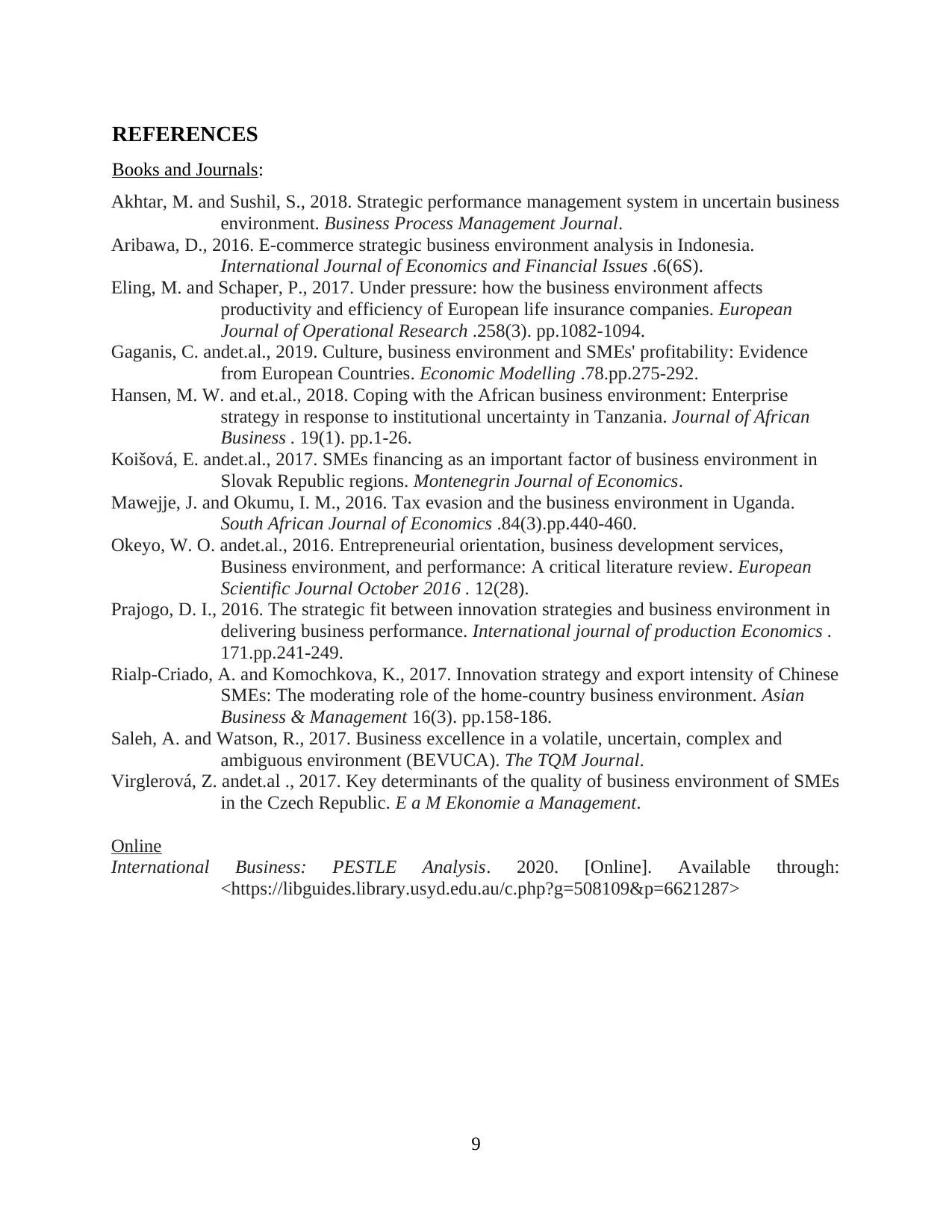
REFERENCES
Books and Journals:
Akhtar, M. and Sushil, S., 2018. Strategic performance management system in uncertain business
environment. Business Process Management Journal.
Aribawa, D., 2016. E-commerce strategic business environment analysis in Indonesia.
International Journal of Economics and Financial Issues .6(6S).
Eling, M. and Schaper, P., 2017. Under pressure: how the business environment affects
productivity and efficiency of European life insurance companies. European
Journal of Operational Research .258(3). pp.1082-1094.
Gaganis, C. andet.al., 2019. Culture, business environment and SMEs' profitability: Evidence
from European Countries. Economic Modelling .78.pp.275-292.
Hansen, M. W. and et.al., 2018. Coping with the African business environment: Enterprise
strategy in response to institutional uncertainty in Tanzania. Journal of African
Business . 19(1). pp.1-26.
Koišová, E. andet.al., 2017. SMEs financing as an important factor of business environment in
Slovak Republic regions. Montenegrin Journal of Economics.
Mawejje, J. and Okumu, I. M., 2016. Tax evasion and the business environment in Uganda.
South African Journal of Economics .84(3).pp.440-460.
Okeyo, W. O. andet.al., 2016. Entrepreneurial orientation, business development services,
Business environment, and performance: A critical literature review. European
Scientific Journal October 2016 . 12(28).
Prajogo, D. I., 2016. The strategic fit between innovation strategies and business environment in
delivering business performance. International journal of production Economics .
171.pp.241-249.
Rialp-Criado, A. and Komochkova, K., 2017. Innovation strategy and export intensity of Chinese
SMEs: The moderating role of the home-country business environment. Asian
Business & Management 16(3). pp.158-186.
Saleh, A. and Watson, R., 2017. Business excellence in a volatile, uncertain, complex and
ambiguous environment (BEVUCA). The TQM Journal.
Virglerová, Z. andet.al ., 2017. Key determinants of the quality of business environment of SMEs
in the Czech Republic. E a M Ekonomie a Management.
Online
International Business: PESTLE Analysis. 2020. [Online]. Available through:
<https://libguides.library.usyd.edu.au/c.php?g=508109&p=6621287>
9
Books and Journals:
Akhtar, M. and Sushil, S., 2018. Strategic performance management system in uncertain business
environment. Business Process Management Journal.
Aribawa, D., 2016. E-commerce strategic business environment analysis in Indonesia.
International Journal of Economics and Financial Issues .6(6S).
Eling, M. and Schaper, P., 2017. Under pressure: how the business environment affects
productivity and efficiency of European life insurance companies. European
Journal of Operational Research .258(3). pp.1082-1094.
Gaganis, C. andet.al., 2019. Culture, business environment and SMEs' profitability: Evidence
from European Countries. Economic Modelling .78.pp.275-292.
Hansen, M. W. and et.al., 2018. Coping with the African business environment: Enterprise
strategy in response to institutional uncertainty in Tanzania. Journal of African
Business . 19(1). pp.1-26.
Koišová, E. andet.al., 2017. SMEs financing as an important factor of business environment in
Slovak Republic regions. Montenegrin Journal of Economics.
Mawejje, J. and Okumu, I. M., 2016. Tax evasion and the business environment in Uganda.
South African Journal of Economics .84(3).pp.440-460.
Okeyo, W. O. andet.al., 2016. Entrepreneurial orientation, business development services,
Business environment, and performance: A critical literature review. European
Scientific Journal October 2016 . 12(28).
Prajogo, D. I., 2016. The strategic fit between innovation strategies and business environment in
delivering business performance. International journal of production Economics .
171.pp.241-249.
Rialp-Criado, A. and Komochkova, K., 2017. Innovation strategy and export intensity of Chinese
SMEs: The moderating role of the home-country business environment. Asian
Business & Management 16(3). pp.158-186.
Saleh, A. and Watson, R., 2017. Business excellence in a volatile, uncertain, complex and
ambiguous environment (BEVUCA). The TQM Journal.
Virglerová, Z. andet.al ., 2017. Key determinants of the quality of business environment of SMEs
in the Czech Republic. E a M Ekonomie a Management.
Online
International Business: PESTLE Analysis. 2020. [Online]. Available through:
<https://libguides.library.usyd.edu.au/c.php?g=508109&p=6621287>
9
⊘ This is a preview!⊘
Do you want full access?
Subscribe today to unlock all pages.

Trusted by 1+ million students worldwide
1 out of 13
Related Documents
Your All-in-One AI-Powered Toolkit for Academic Success.
+13062052269
info@desklib.com
Available 24*7 on WhatsApp / Email
![[object Object]](/_next/static/media/star-bottom.7253800d.svg)
Unlock your academic potential
Copyright © 2020–2025 A2Z Services. All Rights Reserved. Developed and managed by ZUCOL.




